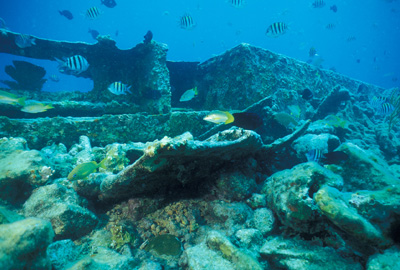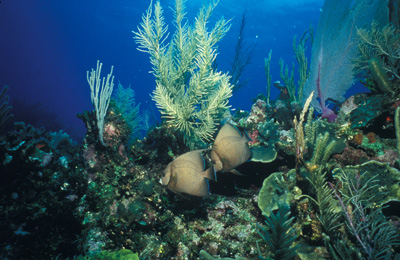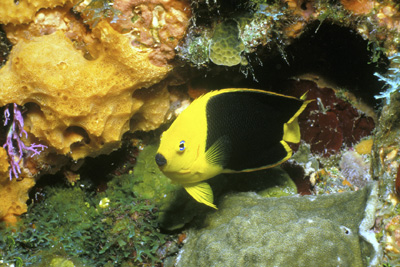
Protecting fragile coral reefs is top priority
For Biscayne National Park in Florida, maintaining coral reefs in mint condition is a top priority. Because of this, Biscayne authorities are tightening security in their park with new security cameras and trained personnel to make sure snorkelers are following park rules.
Biscayne is not the only park keeping close watch on coral reef protection, the U.S. Virgin Islands National Park has also taken measures to protect coral reefs by enforcing fishing regulations, working with law enforcement to issue tickets and court for poachers and extending water boundaries to reduce pressure on the corals.
| Click on the video at the right to view an audio slideshow about protecting coral reefs in national parks narrated and prepared by writer Anabell Bernot. Images courtesy of the National Park Service. |
“Stress on the corals can have a physical and traumatic impact,” said Gary Bremen, an interpretive park ranger and spokesperson for Biscayne National Park in South Florida. “Our job as a national park is to protect an ecosystem without putting up a fence.”
Corals are extremely ancient animals that evolved into modern reef-building forms over the last 25 million years and provide algae with a protected environment necessary for photosynthesis.
They are especially vulnerable to human activities such as trampling and fishing. Anchoring can physically destroy or kill the coral, resulting in reef death.
In order to keep the coral healthy, Biscayne National Park has put forth a proposal for a general management plan to close a 10,000-acre portion as a marine reserve zone where fishing will be prohibited.
 |
The proposal for the 10,000-acre marine reserve zone in Biscayne Bay will close the area to fishing to allow the fish population to grow and benefit coral reef health (Photos courtesy of National Park Service). |
“Our idea is to close this area to fishing so the fish population can grow back,” said Bremen.
“When there are healthy fish in the water that can feed on coral and fertilize, this keeps things in good balance, then coral reefs do better. If things are out of balance it has a negative impact on coral reef health,” he said.
Biscayne National Park was created in 1968 by efforts of a number of organizations, including the Safe Progress Association, to halt the development of an oil refinery on the bay that would have dredged a 40-foot-deep channel that would have also required cutting through the coral reef.
With visitors enjoying attractions like scuba diving, fishing and snorkeling, park personnel have to monitor the coral reefs to make sure that crimes like poaching do not go unnoticed.
“Unfortunately, there is a lot of poaching that goes on so we rely on the public to report a crime since we only have six law enforcement rangers,” said Vanessa McDonough, fishery biologist for the park. “Before people go into the water, our concession operators give them a lecture on the importance of leaving the coral untouched. We also have different signs throughout the park that remind people to ‘look but not touch’.”
| Reefs in Biscayne National Park are not diverse ecosystems because they are located on the northern edge of their natural range. |  |
Other than preventing poaching and touching, fishing tickets or a required once-a-month class can be issued for removing undersized fish.
“If people break the fishing rules, I think it’s better to go with the once-a-month class because the curriculum taught stresses the importance of fishing regulations and that can help fishermen avoid trouble in the future,” said McDonough.
At the end of the course, the fishermen fined take a brief 25-question quiz to test their acquired knowledge.
Laurel Brannick, education specialist for the U.S Virgin Islands National Park, said that most of the problems relating to coral reefs are caused by the actions of people, so it is important that park visitors are part of the solution.
Since 1962, U.S Virgin Islands National Park has protected 5,620 acres of submerged land that is home to coral reefs. Today, the park conducts research and develops policies with the goal of protecting these fragile ecosystems.
“Here at the park we do a lot of research and monitoring to see the changes happening on the reefs,” said Brannick. “In order to keep the corals safe, we have expanded our water boundary and added the Coral Reef National Monument to the park. It is a no take, no anchor zone on the south side of the island.”
 |
A porkfish on the coral reef of Biscayne National Park. Fish like this one feed and fertilize the coral, keeping the coral reef ecosystem in balance. |
The purpose of the monument is to reduce pressure on the corals that occurs when ships and boats drop their anchors.
“What usually happens is an anchor is dropped and a bleaching event occurs, causing diseases to affect the well-being of the corals,” said Jeff Miller, the park’s fisheries biologist.
U.S Virgin Islands National Park hopes to become an anchorless park in the near future.

Comments are Closed